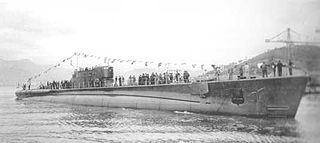
The German Type 212 class, also Italian Todaro class, is a diesel-electric submarine developed by Howaldtswerke-Deutsche Werft AG (HDW) for the German and Italian navies. It features diesel propulsion and an additional air-independent propulsion (AIP) system using Siemens proton exchange membrane (PEM) compressed hydrogen fuel cells. The submarines can operate at high speed on diesel power or switch to the AIP system for silent slow cruising, staying submerged for up to three weeks with little exhaust heat. The system is also said to be vibration-free, extremely quiet and virtually undetectable.

The Italian Navy is the navy of the Italian Republic. It is one of the four branches of Italian Armed Forces and was formed in 1946 from what remained of the Regia Marina after World War II. As of August 2014, the Italian Navy had a strength of 30,923 active personnel, with approximately 184 vessels in service, including minor auxiliary vessels. It is considered a multiregional and a blue-water navy.

Rodrigo is an opera in three acts composed by George Frideric Handel. Its original title was Vincer se stesso è la maggior vittoria. The opera is based on the historical figure of Rodrigo, the last Visigothic king of Spain. The libretto was based on Francesco Silvani's II duello d'Amore e di Vendetta. Dating from 1707, it was Handel's first opera written for performance in Italy, and the first performance took place in Florence late in 1707.

The Nazario Sauro class are diesel-electric submarines operated by the Italian Navy. All boats were built by Fincantieri in Monfalcone.
Luigi Torelli was a Marconi-class submarine of the Italian navy during World War II. The vessel operated in the Atlantic from September 1940 until mid-1943, then was sent to the Far East. After Italy's surrender in 1943, the Torelli was taken over by Nazi Germany's Kriegsmarine, then, in the waning months of the war, the Japanese Imperial Navy. It was one of only two ships to serve in all three major Axis navies, the other being the Italian submarine Comandante Cappellini.
Eva Grimaldi is an Italian actress and model.

The Calvi class was a class of three submarines built by Oderno-Terni-Orlando in Genoa for the Royal Italian Navy. The submarines were built in 1935, and all three served in the Mediterranean at the start of the Second World War. The boats were transferred to the BETASOM Atlantic submarine base at Bordeaux in August 1940. In December 1941 the boats were used for a rescue mission of 254 sailors from the sunken German auxiliary cruiser Atlantis. After Calvi had been sunk, Finzi and Tazzoli were selected for conversion to "transport submarines" in order to exchange rare or irreplaceable trade goods with Japan. Cargo capacity of 160 tons reduced reserve buoyancy from 20–25% to 3.5–6%; and armament was reduced to defensive machine guns.
Pietro Micca was an Italian submarine which served with the Regia Marina in World War II. She was the third ship named after Pietro Micca, the Savoyard soldier who became a national hero for his sacrifice in the defence of Turin against the French troops in 1706. This boat was the prototype for a class of fast, long range submarines with conventional torpedo armament, naval mine laying capability, and useful secret transport capacity. The ship was built at the Tosi shipyard in Taranto. She was laid down on 15 October 1931 and launched on 31 March 1935. The boat fully met design requirements, but was too expensive to be repeated.
Rear Admiral Roberto Camerini is an Italian Navy officer, currently serving as Commander Maritime Command North.

The Škoda 10 cm K10 was a 100 mm (3.9-inch) naval gun of the Austro-Hungarian Navy used as tertiary armament on semi-dreadnought battleships and as primary armament on scout cruisers and destroyers during World War I. After World War I, variants of the Škoda 10 cm K10 were widely produced in Italy as the 100/47 series of guns, which served in a number of roles, on a wide variety of ships, with a number of navies.

Enrico Tazzoli was one of three Calvi-class submarines built for the Regia Marina during the 1930s. Completed in 1936, she played a minor role in the Spanish Civil War of 1936–1939 supporting the Spanish Nationalists. She operated in the Atlantic during the Second World War and was second only to the submarine Leonardo da Vinci as the highest scoring Italian submarine of the conflict. Enrico Tazzoli was converted in 1943 to be a submarine transport for blockade-running between Europe and the Far East. She was lost on her first voyage in this role.
Jantina was one of seven Argonauta-class submarines built for the Regia Marina during the early 1930s. She played a minor role in the Spanish Civil War of 1936–1939 supporting the Spanish Nationalists, and was later sunk during World War II.

During 1955–56 Associazione Calcio Fiorentina competed in Serie A.
The following is the structure of the Italian Navy as of June 2020. It is considered a multiregional and a blue-water navy.

Leonardo da Vinci was a Sauro-class submarine of the Italian Navy.

Primo Longobardo is a Sauro-class submarine of the Italian Navy.

Gianfranco Gazzana Priaroggia is a Sauro-class submarine of the Italian Navy.

The Italian torpedo boat Sagittario was a Spica-class torpedo boat built for the Regia Marina in 1936. During the Battle of the Mediterranean, in the Second World War, Sagittario was involved in several convoy missions, the most notable that known as the "Sagittario convoy", in the course of the Battle of Crete, for which her commander, Giuseppe Cigala-Fulgosi, was awarded the Gold Medal of Military Valour. Sagittario survived the war. Re-classified as corvette in 1949, she was scrapped in 1964.
This page is based on this
Wikipedia article Text is available under the
CC BY-SA 4.0 license; additional terms may apply.
Images, videos and audio are available under their respective licenses.














